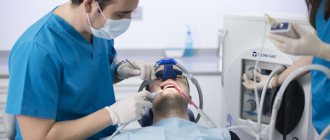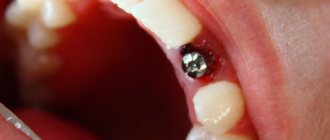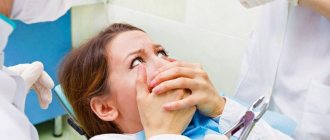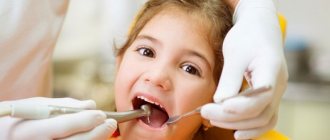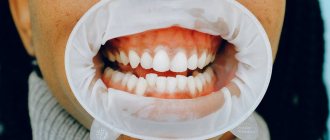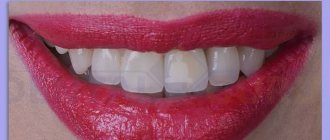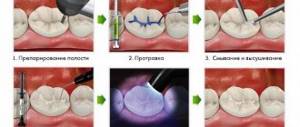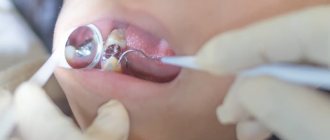Chief editor of the site:
Snitkovsky Arkady Alexandrovich
Chief physician of the professorial dentistry “22 Century”, dentist, orthopedic dentist
Author of the article:
Scientific team of dentistry “22 Century”
Dentists, candidates and doctors of medical sciences, professors
In modern Dentistry “22 Century” dental treatment is painless for the patient
Throughout their lives, most people repeatedly have to consult doctors - dentists of various specialties for the treatment of various dental diseases or, less often, for their prevention. In addition, pathological processes can occur several times, and most are accompanied by pain, the severity of which is determined by the rich mixed innervation of the head and neck.
It is pain that is the “watchdog” of the body, which is the signal of trouble that forces the patient to visit the dental clinic in order to get rid of it or at least reduce it as soon as possible. What can a strong or prolonged attack lead to?
- Disturbance of the balance of the internal environment of the body and the mechanisms of its regulation;
- Adverse effects on the function of organs and systems of the body;
- Increased risk of exacerbation of concomitant diseases;
- Decreased quality of life (impossibility of usual social activities).
From all that has been said, the enormous negative significance of this pathological condition clearly follows.
However, does this mean that complex treatment will also be uncomfortable or even painful for the patient? Of course not!
Anesthesia for dental treatment – Technologies:
- Cofferdam
Make an appointment
Dental treatment under anesthesia makes this goal achievable. At the Auradent clinic, such treatment is carried out using drugs that do not cause drug addiction and are highly effective. These drugs are selected individually after special examinations. The use of anesthesia during dental treatment is indicated for patients who:
- have a low pain sensitivity threshold;
- need dental treatment, which involves a large amount of work;
- have allergic reactions to certain types of anesthesia during dental treatment;
- suffer from somatic diseases (hypertension, cardiac diseases, etc.);
- experience an overwhelming fear of the dentist’s instruments and any of his manipulations;
- have a pronounced gag reflex.
The use of anesthesia made it possible to treat teeth without pain, thereby saving many patients from negative emotions when visiting a dentist. This gentle method even allows dental treatment for children under anesthesia.
The Auradent clinic is certified to provide this type of service and uses only the highest quality and safest drugs, so rest assured that the dental treatment process will now become much more comfortable for you.
When is local anesthesia not used?
Contraindications to local anesthesia in dentistry
- Hypersensitivity to one of the components included in the anesthetic – a history of allergic reactions.
- Ineffectiveness of local anesthesia (for example, at the site of inflammation).
- Long duration and/or complexity of the intervention, the need to anesthetize a large number of anatomical structures or area of the surgical field.
The amount of drug used in this case will exceed the permissible amount and will have toxic and other side effects. Examples include:- operations for tumors;
interventions on the salivary glands;
- manipulations for traumatic injuries of the facial skeleton;
- orthognathic surgery – correction of bite by changing the position and size of jaw segments;
- craniofacial surgery.
- Insurmountable fear of treatment. In these cases, anesthesia is used - a type of general anesthesia, in which the patient is not conscious, or combined anesthesia with premedication - the use of drugs that induce a sleep-like state.
- Mental illness and behavioral disorders.
- Limited mouth opening. The following important points should be taken into account:
- the need to involve an anesthesiological team in the operation;
- potential risks during, before and after surgery;
- significantly higher price (sometimes exceeding the cost of treatment or comparable to it);
- representation mainly in Moscow and other large cities;
- the need for observation after recovery from anesthesia and surgery.
- A preliminary consultation and examination by an anesthesiologist is mandatory, who will determine the specific scheme for administering and maintaining anesthesia or another type of general anesthesia, medications and their dosage, etc. Taking into account ideas about the development of pain syndromes encountered during treatment, other groups of drugs are used:
- non-steroidal anti-inflammatory drugs;
- hormonal anti-inflammatory;
- antispasmodics;
- non-narcotic analgesics;
- narcotic analgesics;
- antidepressants.
Tooth extraction under anesthesia
Tooth extraction without pain can also be carried out thanks to high-quality anesthetics. If local anesthesia is more common in dentistry, general anesthesia is recommended for those patients who plan to remove several teeth at the same time. Anesthesia during tooth extraction is a factor that allows a dental surgeon at the Auradent clinic to remove up to ten teeth in one operation. In addition, tooth extraction under anesthesia is often performed in cases of complex tooth extraction. This definition includes the treatment of impacted, dystopic teeth, as well as wisdom teeth.
Dental treatment under general anesthesia allows Auradent specialists to solve several dental problems of the patient in one visit - for example, to perform treatment, extraction, implantation, and dental prosthetics. This will significantly reduce the stress on the patient and, without loss of quality, will help cure teeth in a short time. The patient's condition is monitored by a specialist anesthesiologist using cardiac monitoring. This guarantees the safety of treatment and tooth extraction at Auradent.
Still have questions?
Local anesthesia
Local anesthesia in dentistry
In the arsenal of our dentistry there are many methods of anesthesia (“freezing”), the leading of which is the so-called. local injection. It involves blocking the conduction of nerve impulses from the source of irritation to the brain and spinal cord while maintaining consciousness and the possibility of verbal contact. The leading role in outpatient practice is ensured by:
- Availability (the most used drug in dentistry);
- Ease of implementation;
- Quality (automated production in sterile factory conditions);
- High efficiency (sufficient depth and duration of action);
- The speed of onset of the effect (“at the tip of the needle”);
- Comparative safety (rare occurrence of complications or their mild severity);
- Low cost.
The constant expansion of the range of anesthetics and instruments used, new application technologies and methods make it possible to carry it out at any dental appointment. Previously, for anesthesia , the patient was redirected to a surgical room or department, which made treatment difficult.
Indications for local anesthesia
Indications for local anesthesia in dentistry
- Prevention of discomfort during:
- professional oral hygiene – “cleaning” (especially for the removal of subgingival tartar from the inner surface of the front teeth on the lower jaw);
- teeth whitening;
- diagnostic manipulations (measuring the depth of periodontal pockets, determining the level of alveolar bone tissue, etc.).
- Treatment of caries (cavity preparation followed by placement of fillings from various materials).
- Treatment of complications of caries - pulpitis and periodontitis, which involves creating access to the tooth cavity, removing its contents, treating the root canal system and filling them. Subsequently, the crown is restored using therapeutic (pin, filling) or orthopedic methods - stump inlays and crowns.
- Extraction of teeth of varying degrees of complexity.
- Operations on soft tissues of the oral cavity:
- plastic surgery of the frenulum of the upper and lower lip and tongue;
- plastic surgery of the oral vestibule (vestibuloplasty);
- elimination of gum recession (loss at the neck of the tooth, “exposing” the root);
- flap periodontal operations;
- increase in the volume of attached gums.
- Dental implantation is the installation of artificial roots made of titanium alloy into the jaw bone tissue for the purpose of subsequent prosthetics.
- Operations on the bone tissues of the jaws:
- open and closed sinus - lifting (an operation to raise the bottom of the maxillary sinus in order to create sufficient height for the installation of dental implants);
- ridge splitting – creating sufficient width of bone tissue before implantation;
- directed bone regeneration – local creation of a bone base in case of its deficiency.
- Dental treatment in children (also serves as an effective measure to prevent fear of treatment and the development of dental phobia, which allows timely seeking dental care).
Types of dental anesthesia
In dental clinics, the following methods of anesthesia are used when removing a tooth or treating it:
- application - an initial remedy for superficial anesthesia of the oral cavity in the form of a gel or spray with an anesthetic;
- infiltration – drugs are injected into the gums;
- conductive - the medicine is administered in close proximity to the nerve endings, used in cases of complex surgical intervention;
- stem - blockade of all branches of the trigeminal nerve, used in a hospital setting.
In each situation, the dentist will choose the necessary anesthetic that will calm the patient and allow the procedure to be carried out without stress. For anesthesia during wisdom tooth removal, treatment of deep caries, and pulp removal, the infiltration method is often chosen.
Do you need painless treatment for inflammation in the oral cavity? Contact the NovaDent clinic! We will help you restore the health and beauty of your smile.
Expert of the article you are reading: Svetlana Viktorovna Derevyakina Chief physician, doctor of the highest qualification category, therapist, periodontist, leading specialist of the NovaDent network
27 years
Clinical experience
Petrovsko-Razumovskaya
Verkhniye Likhobory
st. Dubninskaya, 27, building 1
+7
Free consultation with this specialist
Treatment under anesthesia: common misconceptions
- General anesthesia drugs cause harm to the internal organs and systems of the body.
For general anesthesia, dental medical centers use only certified safe drugs. They are quickly eliminated from the body and do not have a harmful effect on the human body. Numerous clinical studies of patients treated for dental diseases under general anesthesia have not revealed any abnormalities.It is much more harmful not to treat your teeth out of fear of having to visit the dentist. A diseased tooth is a source of constant infection in the body; it is destroyed and will still have to be treated or pulled out.
- General anesthesia is addictive.
When providing dental care, narcotic analgesics are not used. Therefore, the likelihood that dependence and addiction will develop is completely excluded. - After the anesthesia ends, the patient experiences discomfort and even hallucinations.
For general anesthesia, certified safe medications without hallucinogenic effects are used. The likelihood of side effects when using modern drugs is minimized. However, some people may experience discomfort caused by the characteristics of the body. These include headache, body tremors, dizziness, and muscle pain.
Pain relief with local anesthetics
Local anesthetic drugs block nerve endings for a certain period of time. During the treatment process, the patient does not experience pain, but sees and perceives all the actions of the attending physician, and also feels vibrations, touches and pressure. To avoid discomfort, it is recommended to strictly follow the dentist’s instructions, relax as much as possible and inform the doctor if the slightest pain occurs.
Application anesthesia is the only method of pain relief without injections. The doctor simply applies a spray, ointment or gel with an anesthetic - usually lidocaine or benzocaine - to the gum area. Application anesthesia blocks sensitivity to a minimal extent and for a short time. This type of anesthesia is usually used for simple procedures. For example, if it is necessary to remove a baby tooth, remove tartar, or open a small abscess. Also, applications with an anesthetic are applied before an injection into the gums for deeper pain relief.
Infiltration anesthesia is a traditional injection into the area of projection of the tooth root; it acts on peripheral nerve endings. This type of anesthesia is used for canal treatment, nerve removal and other dental procedures. It's no secret that many people are no less afraid of injections than of drills. Therefore, to ensure that the injection into the gum does not cause discomfort, topical anesthesia is applied to the injection site. For injections, special carpule syringes with ultra-thin needles are used.
Conduction anesthesia is an injection into the area of projection of the nerve and the nerve group of teeth. It is used if the patient is not affected by infiltration anesthesia, as well as if prolonged manipulations need to be performed. For example, to treat several teeth at once, to install implants, to perform gum surgery in the treatment of late stages of periodontitis.
Local anesthetic drugs will turn off pain sensitivity for a period of 40-120 minutes. This time is sufficient for most medical procedures.
In fairly rare situations, local anesthetic drugs do not have an effect on the patient. The effect of pain relief can be reduced to “no” by:
- severe dental phobia;
- individual insensitivity;
- individual feature of the location of nerve trunks.
Local anesthesia cannot be used in case of allergic intolerance to local anesthetics or their components. Therefore, before the injection, an allergy history must be collected (if indicated, an allergy test).
Dental treatment under medicinal sedation in dentistry
With an honest and objective approach, one cannot say that sedation is bad and anesthesia is good. Given proper medical indications, both technologies are correct, with mandatory consideration of the method of drug administration and contraindications. If the patient just notes a slight fear, discomfort during dental procedures in the mouth, or wants to cure a couple (no more) of teeth or remove one tooth, then in this case it is anesthesiological care in the form of sedation, which is characterized by a shallow, light nap, that is indicated.
Indications for pain relief
Anesthesia for dental treatment is necessary if:
- minor surgical procedures;
- removal of one or more teeth;
- purulent inflammation of dental tissues;
- depulpation;
- periodontal inflammation and deep caries;
- neuritis or neuralgia of the facial nerve.
The drugs used by our clinic specialists are safe for health. But sometimes anesthesia during tooth extraction or treatment is impossible. The most common contraindications to pain relief: allergic reactions to painkillers, acute diseases of the cardiovascular system, diabetes, hormonal disorders. Your doctor will determine a treatment plan based on these factors.
The removal of wisdom teeth causes a lot of fears and concerns among patients. During their eruption, pain and purulent inflammation may occur, which require immediate treatment. Dentists at NovaDent clinics dispel myths about the pain of treatment.
Anesthesia in dentistry
Not so long ago, a real “boom” of treatment under general anesthesia began in the field of dental services. This is, of course, due to the fact that modern anesthesiology has a whole arsenal of reliable and well-tested drugs; it is possible to give “light” anesthesia, which does not require hospitalization and subsequent observation of the patient in a hospital.
Of course, anyone wants to have their teeth treated without pain. But are all types of anesthesia so good and how to understand their diversity? We decided to find out from the anesthesiologist-resuscitator, Sergei Yuryevich Kim, a specialist at the Dentey family dental clinic.
— Sergey Yuryevich, in the information brochures of the Denteya dental clinic, special emphasis is placed on treatment under general anesthesia. Is this really so rare or what is special?
Let me start with the fact that not every dentist in Moscow can offer dental treatment under general anesthesia, especially when it comes to children. A dental clinic needs not only to attract a highly qualified anesthesiologist-resuscitator, but also to equip the clinic with the appropriate devices.
At Denteya Dentistry, we provide dental treatment using inhalation sedation, nitrous oxide, and intravenous anesthesia. When a large number of teeth are to be treated or several implants are installed, even adult, patient patients cannot always physically withstand so many hours. Of course, it is not worth putting such treatment under general anesthesia right away; “light” sedation will suffice.
But unlike a regular injection of an anesthetic, which can be done by the dentist himself, sedation requires a qualified anesthesiologist-resuscitator.
— What is “laughing gas”? Is this also a type of anesthesia? Are you using it?
Yes, we use nitrous oxide or “laughing gas” as it is called. This type of anesthesia is better suited for dental treatment, especially in children and adults who find it difficult to withstand the procedure.
During orthopedic operations (installation of dental implants), intravenous anesthesia is used. The main type of anesthesia used is inhalation general anesthesia.
— When treating children or adults, is general anesthesia more often used?
General anesthesia is more often used in pediatric dentistry, as well as in dental treatment for people with neurological pathologies (cerebral palsy, autism) - this can be either a small patient or an adult.
There is another category of patients - adults who are allergic to local anesthetics. General anesthesia is also suitable for them.
A clear advantage of dental treatment under general anesthesia is that all problems can be completely solved in one go. That is, one tooth is usually treated under local anesthesia, another tooth is treated at the next appointment, etc. With general anesthesia, the dentist does everything at once.
— What happens to a person during sedation - does he fall asleep?
Not quite, the person is conscious, but this is the so-called “twilight” consciousness.
There is a type of deeper sedation - intravenous sedation using Propofol. It is performed on adult patients when it is necessary to treat several teeth over 2-5 hours. Intravenous sedation is similar to general anesthesia.
There is also xenon anesthesia. It is very promising, but today it is quite expensive. Perhaps we will introduce this method in our clinic. Xenon has not only an anesthetic, but also a rehabilitative effect during stress.
— What drugs do you use for anesthesia?
For children - Sevoflurane (commercial name - Sevoran). Modern inhalational anesthetic. In adults, in addition to it, others are used - Diprivan, Propofol.
— What anesthesia machine is installed at Denteya Dentistry?
Our clinic has a modern German device, Draeger Fabius Plus, and a gas analyzer from the same manufacturer.
— Before dental treatment under anesthesia, should the patient undergo any tests?
Yes, a small health screening is always carried out. For children, this is a general or clinical blood test, a test for the duration of bleeding, and an ECG. If a child has chronic diseases, additional consultation with specialists is needed.
For adult patients, a general blood test is added to this kit. If they take drugs that affect blood clotting, they need to do a blood clotting test and tests for infections (AIDS, hepatitis, syphilis).
— Briefly describe the algorithm for preparing and conducting treatment under anesthesia.
First, you need to be examined by a dentist and draw up a treatment plan, which indicates the approximate time of anesthesia. After this, a consultation is held with an anesthesiologist-resuscitator, who provides all the information on the risks and possible contraindications. Then, if children are involved, the parents make the decision. If you are ready for treatment under general anesthesia, they begin taking tests and, if necessary, conduct further examinations. Then the time for the procedure is set. Before it, you must also take some measures (appear on an empty stomach, that is, do not eat or drink).
— After dental treatment under general anesthesia or sedation, can a person leave the clinic immediately after completing the procedure?
The practice with children is this: after the procedure is completed, the child and his parents remain in the clinic for some time. We have a special rest room for this in the clinic. There is no time limit in it. Parents can stay there as long as they see fit until they are sure that the child is ready to go home.
— After the parents and the child return home, are there any restrictions on food intake?
The child can be given food and drink only an hour after the end of the procedure. Moreover, in the clinic itself, after treatment, we give a little water or juice without pulp under the supervision of a doctor to eliminate the unpleasant taste in the mouth.
— Does anesthesia provide some kind of painkiller with a prolonged effect? After all, waking up from anesthesia after tooth extraction or another procedure can be very painful.
When performing general anesthesia, local anesthesia is not used, since Sevoran (sevoflurane) has a mild analgesic effect. But when it comes to tooth extraction, we always use local anesthesia. I'll explain the reasons. As you recover from anesthesia, when the effect of Sevoflurane weakens, the analgesic effect also weakens. Therefore, if additional pain relief is not given, in a borderline state of drowsiness, when the anesthesia wears off, the child may wake up from acute pain. To prevent acute pain, we give local anesthesia.
— What are the contraindications to anesthesia?
General anesthesia, in principle, can be performed on almost any patient. Sevoran is good for everyone, but can sometimes cause complications. For example, malignant hyperthermia syndrome. This is a rare complication. Nevertheless, it has its place.
— If we consider it as a whole, is general anesthesia dangerous for children or adults? If yes, to what extent?
Having modern inhalation anesthesia, monitoring equipment, etc., we can say that it is safe. Local anesthesia is good because it is local. But you need to take into account that the local anesthetic enters the bloodstream and an allergy may occur. The doctor must decide with the individual patient how to make the treatment safe.
Sergey Yurievich, thank you! Your first-person account clarifies many points regarding anesthesia in dentistry. Let's hope that this information will help our readers treat their teeth competently and painlessly!
Dentistry "Dentey" +7
Conditions for dental treatment under medical sedation or anesthesia
LO-77-01-006479. Appendix N 1. Page 1
- A dental clinic must have a license for anesthesiology and resuscitation . Under no circumstances should you buy into the offer of a private visiting anesthesiologist, with a small number of ampoules “in your pocket”.
- Also, the clinic must have a separate license for potent drugs . The use of anesthetic support without such state permission is illegal!
- The clinic must be equipped with all auxiliary anesthetic equipment, regulated by the procedure for providing anesthesiological resuscitation care (order 919n).
- Doctors conducting the intervention must be on the staff of the organization.


